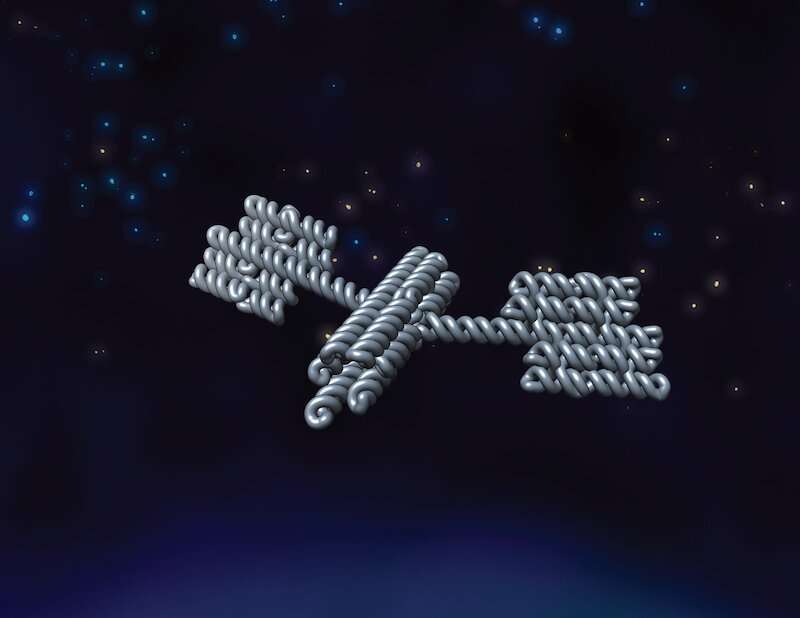Nanosatellite shows the way to RNA medicine of the future


The RNA molecule is commonly recognized as messenger between DNA and protein, but it can also be folded into intricate molecular machines. An example of a naturally occurring RNA machine is the ribosome, that functions as a protein factory in all cells.
Inspired by natural RNA machines, researchers at the Interdisciplinary Nanoscience Center (iNANO) have developed a method called “RNA origami,” which makes it possible to design artificial RNA nanostructures that fold from a single stand of RNA. The method is inspired by the Japanese paper folding art, origami, where a single piece of paper can be folded into a given shape, such as a paper bird.
Frozen folds provide new insight
The research paper in Nature Nanotechnology describes how the RNA origami technique was used to design RNA nanostructures, that were characterized by cryo-electron microscopy (cryo-EM) at the Danish National cryo-EM Facility EMBION. Cryo-EM is a method for determining the 3D structure of biomolecules, which works by freezing the sample so quickly that water does not have time to form ice crystals, which means that frozen biomolecules can be observed more clearly with the electron microscope.
Images of many thousands of molecules can be converted on the computer into a 3D map, that is used to build an atomic model of the molecule. The cryo-EM investigations provided valuable insight into the detailed structure of the RNA origamis, which allowed optimization of the design process and resulted in more ideal shapes.
“With precise feedback from cryo-EM, we now have the opportunity to fine-tune our molecular designs and construct increasingly intricate nanostructures,” explains Ebbe Sloth Andersen, associate professor at iNANO, Aarhus University.
Discovery of a slow folding trap
Cryo-EM images of an RNA cylinder sample turned out to contain two very different shapes, and by freezing the sample at different times it was evident that a transition between the two shapes was taking place. Using the technique of small-angle X-ray scattering (SAXS), where the samples are not frozen, the researchers were able to observe this transition in real time and found that the folding transition occurred after approx. 10 hours.
The researchers had discovered a so-called “folding trap” where the RNA gets trapped during transcription and only later gets released.
“It was quite a surprise to discover an RNA molecule that refolds this slow since folding typically takes place in less than a second” tells Jan Skov Pedersen, Professor at Department of Chemistry and iNANO, Aarhus University.
“We hope to be able to exploit similar mechanisms to activate RNA therapeutics at the right time and place in the patient,” explains Ewan McRae, the first author of the study, who is now starting his own research group at the “Centre for RNA Therapeutics” at the Houston Methodist Research Institute in Texas, U.S..

Construction of a nanosatellite from RNA
To demonstrate the formation of complex shapes, the researchers combined RNA rectangles and cylinders to create a multi-domain “nanosatellite” shape, inspired by the Hubble Space Telescope.
“I designed the nanosatellite as a symbol of how RNA design allows us to explore folding space (possibility space of folding) and intracellular space, since the nanosatellite can be expressed in cells,” says Cody Geary, assistant professor at iNANO, who originally developed the RNA-origami method.
However, the satellite proved difficult to characterize by cryo-EM due to its flexible properties, so the sample was sent to a laboratory in the U.S., where they specialize in determining the 3D structure of individual particles by electron tomography, the so-called IPET-method.
“The RNA satellite was a big challenge! But by using our IPET method, we were able to characterize the 3D shape of individual particles and thus determine the positions of the dynamic solar panels on the nanosatellite,” says Gary Ren from the Molecular Foundry at Lawrence Berkeley National Laboratory, California, U.S..
The future of RNA medicine
The investigation of the RNA origamis contributes to improving the rational design of RNA molecules for use in medicine and synthetic biology. A new interdisciplinary consortium, COFOLD, supported by the Novo Nordisk Foundation, will continue the investigations of RNA folding processes by involving researchers from computer science, chemistry, molecular biology, and microbiology to design, simulate and measure folding at higher time resolution.
“With the RNA design problem partially solved, the road is now open to creating functional RNA nanostructures that can be used for RNA-based medicine, or act as RNA regulatory elements to reprogram cells,” says Ebbe Sloth Andersen.
More information:
Ebbe Andersen, Structure, folding and flexibility of co-transcriptional RNA origami, Nature Nanotechnology (2023). DOI: 10.1038/s41565-023-01321-6. www.nature.com/articles/s41565-023-01321-6
Provided by
Aarhus University
Citation:
Nanosatellite shows the way to RNA medicine of the future (2023, February 27)
retrieved 27 February 2023
from https://phys.org/news/2023-02-nanosatellite-rna-medicine-future.html
This document is subject to copyright. Apart from any fair dealing for the purpose of private study or research, no
part may be reproduced without the written permission. The content is provided for information purposes only.



